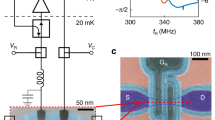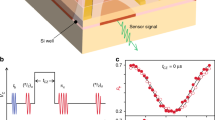Abstract
Silicon spin qubits are one of the leading platforms for quantum computation1,2. As with any qubit implementation, a crucial requirement is the ability to measure individual quantum states rapidly and with high fidelity. Since the signal from a single electron spin is minute, the different spin states are converted to different charge states3,4. Charge detection, so far, has mostly relied on external electrometers5,6,7, which hinders scaling to two-dimensional spin qubit arrays2,8,9. Alternatively, gate-based dispersive read-out based on off-chip lumped element resonators has been demonstrated10,11,12,13, but integration times of 0.2–2 ms were required to achieve single-shot read-out14,15,16. Here, we connect an on-chip superconducting resonant circuit to two of the gates that confine electrons in a double quantum dot. Measurement of the power transmitted through a feedline coupled to the resonator probes the charge susceptibility, distinguishing whether or not an electron can oscillate between the dots in response to the probe power. With this approach, we achieve a signal-to-noise ratio of about six within an integration time of only 1 μs. Using Pauli’s exclusion principle for spin-to-charge conversion, we demonstrate single-shot read-out of a two-electron spin state with an average fidelity of >98% in 6 μs. This result may form the basis of frequency-multiplexed read-out in dense spin qubit systems without external electrometers, therefore simplifying the system architecture.
This is a preview of subscription content, access via your institution
Access options
Access Nature and 54 other Nature Portfolio journals
Get Nature+, our best-value online-access subscription
$29.99 / 30 days
cancel any time
Subscribe to this journal
Receive 12 print issues and online access
$259.00 per year
only $21.58 per issue
Buy this article
- Purchase on Springer Link
- Instant access to full article PDF
Prices may be subject to local taxes which are calculated during checkout



Similar content being viewed by others
Data availability
The data reported in this paper are archived at https://doi.org/10.4121/uuid:8df1a6fa-9230-400f-a790-1b7714b1aad5.
Change history
25 November 2019
An amendment to this paper has been published and can be accessed via a link at the top of the paper.
References
Zwanenburg, F. A. et al. Silicon quantum electronics. Rev. Mod. Phys. 85, 961 (2013).
Vandersypen, L. M. K. et al. Interfacing spin qubits in quantum dots and donors—hot, dense and coherent. npj Quantum Inf. 3, 34 (2017).
Ono, K., Austing, D. G., Tokura, Y. & Tarucha, S. Current rectification by Pauli exclusion in a weakly coupled double quantum dot system. Science 297, 5585 (2002).
Elzerman, J. M. et al. Single-shot read-out of an individual electron spin in a quantum dot. Nature 430, 431–435 (2004).
Hanson, R., Kouwenhoven, L. P., Petta, J. R., Tarucha, S. & Vandersypen, L. M. K. Spins in few-electron quantum dots. Rev. Mod. Phys. 79, 1217 (2007).
Field, M. et al. Measurements of Coulomb blockade with a noninvasive voltage probe. Phys. Rev. Lett. 70, 1311–1314 (1993).
Barthel, C. et al. Fast sensing of double-dot charge arrangement and spin state with a radio-frequency sensor quantum dot. Phys. Rev. B 81, 161308 (2010).
Li, R. et al. A crossbar network for silicon quantum dot qubits. Sci. Adv. 4, eaar3960 (2018).
Veldhorst, M., Eenink, H. G. J., Yang, C. H. & Dzurak, A. S. Silicon CMOS architecture for a spin-based quantum computer. Nat. Commun. 8, 1766 (2017).
Colless, J. I. et al. Dispersive readout of a few-electron double quantum dot with fast rf gate sensors. Phys. Rev. Lett. 110, 046805 (2013).
Betz, A. C. et al. Dispersively detected Pauli spin-blockade in a silicon nanowire field-effect transistor. Nano Lett. 15, 4622–4627 (2015).
House, M. G. et al. Radio frequency measurements of tunnel couplings and singlet–triplet spin states in Si:P quantum dots. Nat. Commun. 6, 8848 (2015).
Crippa, A. et al. Gate-reflectometry dispersive readout of a spin qubit in silicon. Preprint at https://arxiv.org/abs/1811.04414 (2018).
Pakkiam, P. et al. Single-shot single-gate rf spin readout in silicon. Phys. Rev. X 8, 041032 (2018).
West, A. et al. Gate-based single-shot readout of spins in silicon. Nat. Nanotechnol. 14, 437–441 (2019).
Urdampilleta, M. et al. Gate-based high fidelity spin read-out in a CMOS device. Preprint at https://arxiv.org/abs/1809.04584 (2018).
Gonzalez-Zalba, M. F., Barraud, S., Ferguson, A. J. & Betz, A. C. Probing the limits of gate-based charge sensing. Nat. Commun. 6, 6084 (2015).
Rossi, A., Zhao, R., Dzurak, A. S. & Gonzalez-Zalba, M. F. Dispersive readout of a silicon quantum dot with an accumulation-mode gate sensor. Appl. Phys. Lett. 110, 212101 (2017).
de Jong, D. et al. Rapid detection of coherent tunneling in an InAs nanowire quantum dot through dispersive gate sensing. Phys. Rev. Appl. 11, 044061 (2019).
Samkharadze, N. et al. Strong spin–photon coupling in silicon. Science 359, 1123–1127 (2018).
Samkharadze, N. et al. High-kinetic-inductance superconducting nanowire resonators for circuit QED in a magnetic field. Phys. Rev. Appl. 5, 044004 (2016).
Cottet, A., Mora, C. & Kontos, T. Mesoscopic admittance of a double quantum dot. Phys. Rev. B 83, 121311 (2011).
Petersson, K. D. et al. Circuit quantum electrodynamics with a spin qubit. Nature 490, 380–383 (2012).
Frey, T. et al. Dipole coupling of a double quantum dot to a microwave resonator. Phys. Rev. Lett. 108, 046807 (2012).
Chorley, S. J. et al. Measuring the complex admittance of a carbon nanotube double quantum dot. Phys. Rev. Lett. 108, 036802 (2012).
Landig, A. J. et al. Microwave cavity detected spin blockade in a few electron double quantum dot. Preprint at https://arxiv.org/abs/1811.03907 (2018).
Schuster, D. I. et al. AC Stark shift and dephasing of a superconducting qubit strongly coupled to a cavity field. Phys. Rev. Lett. 94, 123602 (2005).
Mizuta, R., Otxoa, R. M., Betz, A. C. & Gonzalez-Zalba, M. F. Quantum and tunneling capacitance in charge and spin qubits. Phys. Rev. B 95, 045414 (2017).
Stehlik, J. et al. Fast charge sensing of a cavity-coupled double quantum dot using a Josephson parametric amplifier. Phys. Rev. Appl. 4, 014018 (2015).
Mi, X. et al. A coherent spin–photon interface in silicon. Nature 555, 599–603 (2018).
Bienfait, A. et al. Controlling spin relaxation with a cavity. Nature 531, 74–77 (2016).
Barthel, C., Reilly, D. J., Marcus, C. M., Hanson, M. P. & Gossard, A. C. Rapid single-shot measurement of a singlet–triplet qubit. Phys. Rev. Lett. 103, 160503 (2009).
Veldhorst, M. et al. An addressable quantum dot qubit with fault-tolerant control-fidelity. Nat. Nanotechnol. 9, 981–985 (2014).
Yoneda, J. et al. A quantum-dot spin qubit with coherence limited by charge noise and fidelity higher than 99.9%. Nat. Nanotechnol. 13, 102–106 (2018).
Khalil, M. S., Stoutimore, M. J. A., Wellstood, F. C. & Osborn, K. D. An analysis method for asymmetric resonator transmission applied to superconducting devices. J. Appl. Phys. 111, 054510 (2012).
Acknowledgements
The authors thank T.F. Watson, J.P. Dehollain, P. Harvey-Collard, U.C. Mendes, B. Hensen and other members of the spin qubit team at QuTech for useful discussions, L.P. Kouwenhoven and his team for access to NbTiN films, and P. Eendebak and L. Blom for software support. This research was undertaken thanks in part to funding from the European Research Council (ERC Synergy Quantum Computer Lab), the Netherlands Organisation for Scientific Research (NWO/OCW) as part of the Frontiers of Nanoscience (NanoFront) programme and Intel Corporation.
Author information
Authors and Affiliations
Contributions
G.Z., N.S. and L.M.K.V. conceived and planned the experiments. G.Z. and M.L.N. carried out the experiments. A.S. grew the heterostructure with G.S.’s supervision. N.S. designed and fabricated the device. D.B. and N.K. contributed to sample fabrication. G.Z., M.L.N. and L.M.K.V. analysed the results. G.Z. and L.M.K.V. wrote the manuscript with input from all co-authors. L.M.K.V. supervised the project.
Corresponding author
Ethics declarations
Competing interests
The authors declare no competing interests.
Additional information
Peer review information: Nature Nanotechnology thanks Hongwen Jiang and the other, anonymous, reviewer(s) for their contribution to the peer review of this work.
Publisher’s note: Springer Nature remains neutral with regard to jurisdictional claims in published maps and institutional affiliations.
Supplementary information
Supplementary Information
Supplementary Figs. 1–2
Rights and permissions
About this article
Cite this article
Zheng, G., Samkharadze, N., Noordam, M.L. et al. Rapid gate-based spin read-out in silicon using an on-chip resonator. Nat. Nanotechnol. 14, 742–746 (2019). https://doi.org/10.1038/s41565-019-0488-9
Received:
Accepted:
Published:
Issue Date:
DOI: https://doi.org/10.1038/s41565-019-0488-9
This article is cited by
-
Long-lived valley states in bilayer graphene quantum dots
Nature Physics (2024)
-
Non-symmetric Pauli spin blockade in a silicon double quantum dot
npj Quantum Information (2024)
-
Compilation and scaling strategies for a silicon quantum processor with sparse two-dimensional connectivity
npj Quantum Information (2023)
-
Noisy intermediate-scale quantum computers
Frontiers of Physics (2023)
-
Coupling and readout of semiconductor quantum dots with a superconducting microwave resonator
Science China Physics, Mechanics & Astronomy (2023)



